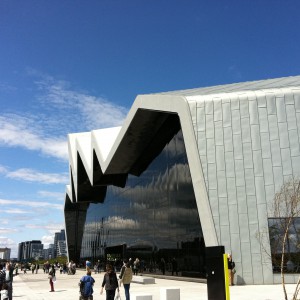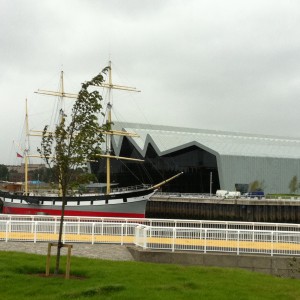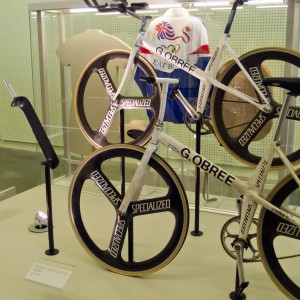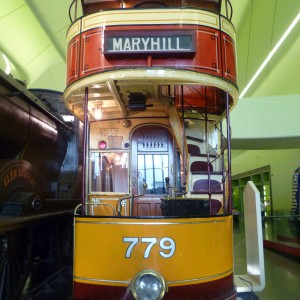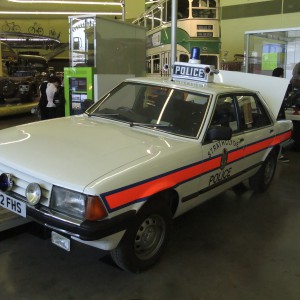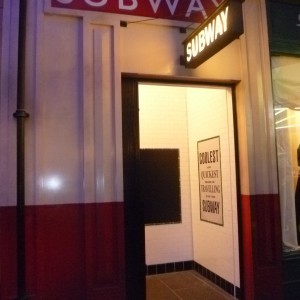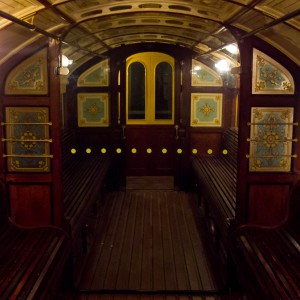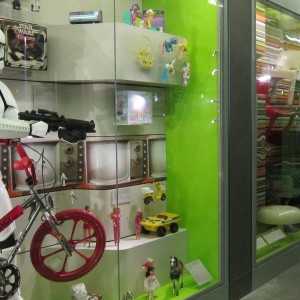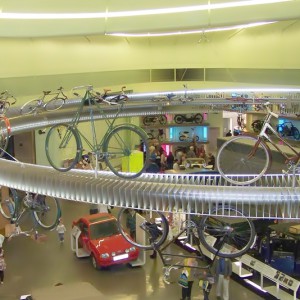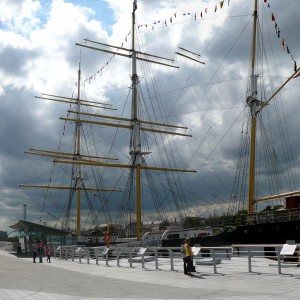Quick Adventures: The Riverside Museum and Tall Ship
Glasgow’s Museum of Transport has a lot of surprises inside and out.
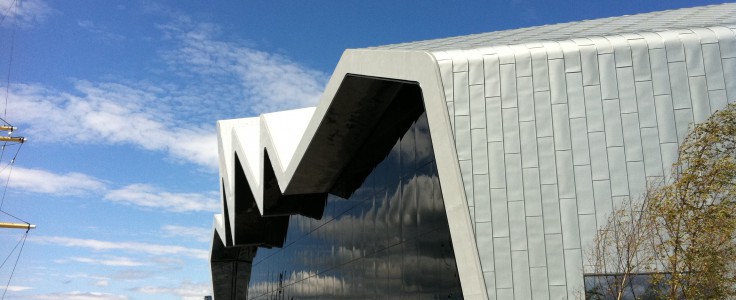
Did you know not far from campus is the European Museum of the Year 2013? Yeah, us neither. Unfortunately it’s not the University’s Hunterian, which is pretty good anyway, don’t turn your nose up at it’s lack of awards. It’s like the Leonardo DiCaprio of museums. But it turns out that our humble little Riverside Museum (aka the Transport Museum) is such a museum. It’s Glasgow’s newest museum, only opening in 2011. So getting the Museum of the Year award after only two years is quite something. It was built to replace the old Transport Museum at Kelvinhall, opposite the Kelvingrove Art Gallery and Museum (another must-visit museum in Glasgow) and actually has more than twice as many items as the old one. The building itself is supposed to look like waves to reflect Glasgow’s maritime history, the fact that it is on the confluence of the rivers Kelvin and Clyde and that the site is on an old shipyard. But you can’t really appreciate the views from the ground, you can see a bit of what the architect was hoping for if you are on a train going through Partick station, but not much sadly.
It’s kind of difficult to get to unless you have a boat (there is a working pier outside the museum and you might still be able to get the free ferry service to Govan — depends on the season). But the simplest way to get there from campus is to walk. Go to the bottom of Byres Road, turn right on to Dumbarton Road, walk for around 10 minutes until you see Morrisons and the Partick bus stop, rail and Subway station on your left. Walk to the corner where Morrisons ends and the railway station begins and walk through the little promenade. Cross the road and walk over the bridge that goes over the motorway. The bridge itself tells you a bit about the history of the area — basically all along the banks of the Clyde here were dockyards and warehouses. Turn to look back and you can see quite a bit of Glasgow as you are now reasonably high up — you can see the familiar University Tower! Take a left and walk for another 5 minutes and you’ll see the Riverside Museum on your right. From this angle you can kind of understand what the architect was going for. There are signs up to help you as well.
Outside the museum are a pair of giant astroturf covered chairs. No, we don’t know why. But it is tradition that you take a photograph of yourself sitting on them. There’s also an ice cream stall outside should it be a rare hot day.
Inside the entrance is a bewildering collection of everything! Cars, bicycles, skateboards, locomotives, trams, Faslane Peace Caravans … just to give you an idea of how much stuff there is in the museum.
As you wander about the ground floor (it’s pretty big, you might end up lost and going in circles) there’s plenty of transport-themed stuff just lying around — a huge wall of cars, vintage motorcycles, a velodrome of bicycles suspended from the ceiling, old row-boats, a Graeme Obree exhibition (aka the Flying Scotsman, two-time fastest cyclist in the world), dismantled engines (for the engineering students), a massive steam train (built in Glasgow in 1945 and used to haul cargo and passengers across South Africa, cool old trams you can get in and not one but two old Glasgow Subway cars (in different exhibits) that you can get in.
Upstairs has some more displays, it’s a bit more arty and one-off. It’s a bit less hectic upstairs as well if you don’t like large crowds. And you get some decent views down on to the main museum floor.
There are quite a few special displays like the conveyor belt of model ships, the exhibition about Clyde-built blockade runners in the American Civil War, World War 1 ship camouflage, an old timey Photographer’s Studio where you can dress up in old timey clothes and get a photograph taken, The Adventurers (contemporary Scottish adventurers like Glasgow alumnus Mark Beaumont) and an old cobbled stone 1920s street with sound/light effects and shops that you can go into.
Additionally, there’s lots of extra weird items — like a red phone box (pfft, the University has two), a lot of 1960s Glasgow ‘stuff’ like prams, a Clyde estuary wildlife display of stuffed animals, 1970s calculators, dresses, a display of shoes and an airport scanner.
If you go out and around the back of the museum you’ll find the 75 metre long triple masted Tall Ship Glenlee. It was originally built in Glasgow and sailed around the world many times over before ending up as Spanish sail training ship for a long time. There’s an awesome play area in the cargo hold (it says for children up to 7 years old but you can get away with it if there’s no children around). It is a realllly big ship, you can climb up to the poop deck and see how far down into the water it is. There are quite a few sea tales written down, plus old nautical charts, and you can play with the tiller or swab the deck as you would have done almost 110 years ago when the ship was first built.
It being in Glasgow, and half of the cars being from the 1970 through to the 1990s make it look like a set from classic Glasgow crime drama Taggart (non-Scottish students should ask a Scottish friend). Which is great. Does anyone remember the episode where the killer was actually the SRC President? Another bunch of cars and motorbikes are from the 1930s and 1940s, which makes it look like a set from classic World War 2 comedy ‘Allo ‘Allo. Which is great too.
All-in-all, if you like cool old things that used to move, then this is a great museum. It has a lot of interactive displays as well as cool things to look at. Getting to board an old sailing boat is pretty cool too. Like all Glasgow City Council museums, it’s free. As is entry to the Tall Ship.
- The Riverside Museum front view.
- Riverside Museum view from Govan.
- Graeme Obree’s ‘Old Faithful’ replica bicycles.
- A double decker tram to Maryhill.
- Strathclyde Police Ford Granada.
- Old Glasgow Subway entrance.
- Interior of an old Glasgow Subway car.
- Toys from the 1980s.
- The suspended ‘velodrome’ showing all the bicycles.
- The SV Glenlee at anchor.
